Swimming with Crocodiles in Banco Chinchorro
Originally, the thought of getting in the water with a crocodile scared the daylights out of me. But now that I’ve done it, I can honestly say that discovering the Banco Chinchorro expedition, pushing myself to overcome my fear, and coming face-to-face with these modern-day dinosaurs has been the most enlightening experience of my life!
Into the Wild
The expedition starts off in Xcalak, at XTC Dive Center, where we get on a boat to travel to Banco Chinchorro. Getting out to Banco Chinchorro is half of the adventure! It’s a two hour journey which, depending on the weather, can be both bumpy and exciting.
Upon arriving, we quickly noticed the rustic living quarters; a fisherman's hut over the ocean. No cell phone service, no internet, just the ocean and the crocs. Imagine sleeping in a hammock with a mosquito net zipped up, how awesome is that?! Finally, a place to truly disconnect and become one with nature. In the mornings we dive the pristine, untouched reefs and spear lionfish. We eat some of the lionfish and some of it is also used to bring the crocs in. However, we also notice that the crocs are alerted by the boat engine, like a dinner bell that lures them to the fishermen hut; a learned behavior.
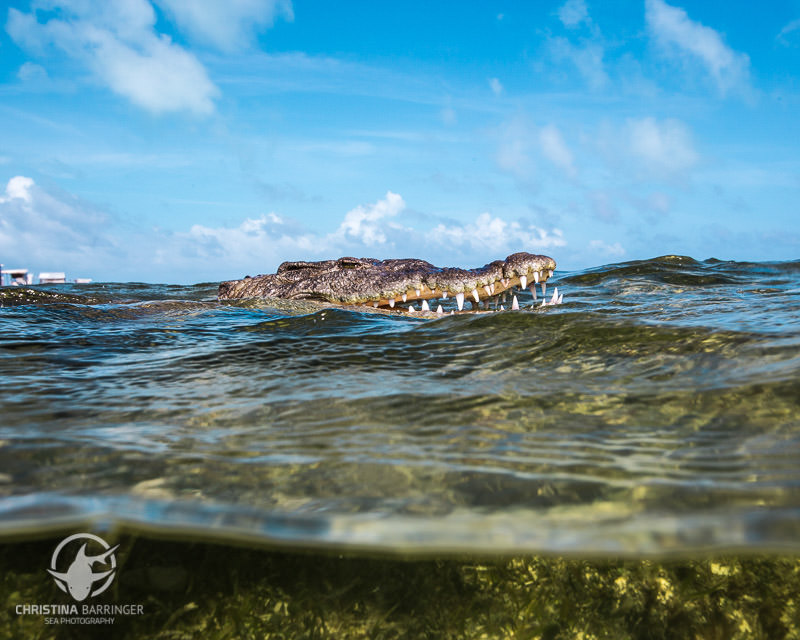
This has been a recreational expedition for only five seasons, making it one of the newest and most exciting adventures out there!
Banco Chinchorro is an Atoll that’s close to Belize, but is still considered to be in Mexican waters. There are about 400 American crocodiles there and they are the purest, genetically speaking, of their kind. Banco Chinchorro is, geologically, a “false atoll”, meaning there is a reef lagoon within the coral ring. Inside the lagoon there are three islands. The crocodiles reside within the large mangroves found along the largest island, Cayo Centro. Inside the mangroves, the crocodiles are most comortable, and are in hunting mode. Once they exit the mangroves and enter the reef lagoon, they are less sheltered and not in hunting mode, allowing us to approach them.
Swimming with Crododiles
With specific strategies, and the expert guidance provided by XTC Dive Center, you can get in the water with these fascinating animals. It would not be safe to enter the water in the mangroves where they are comfortable hunters. For this reason, we only use a designated dive area near the fishermen hut, where the crew and spotters can observe for safety purposes.
The American crocs in Banco Chinchorro are a good size, but still small compared to other places. This is due to their diet. In Banco Chinchorro they feed on birds and fish. In places like Costa Rica, where they can feed on cows and sometimes even people, they get much larger.
While the largest croc that has been encountered in Banco Chinchorro is 15-ft, the largest I personally encountered was a 13-ft female named Gambit. Regardless, once you come face-to-face with these modern-day dinosaurs, you won't notice the differences in their sizes. But you will certainly notice how powerful and highly intelligent these apex predators are.
XTC Dive Center’s expedition leaders provide expert training and guidance. Not only is safety a priority but so is respect for the animals. These are two very important things to me. As far as their safety qualifications - to this day, XTC Dive Center has not experienced any accidents while running this expedition.
Gear Used:
- Canon 6D in a Nauticam housing
- Canon 16-35mm wide angle lens
- 10 inch Zen Underwater glass dome with extension ring
- Canon 8-15mm fisheye lens
- 4 inch Zen Underwater glass dome
- Dual Sea & Sea YS110a strobes, Ultra Light arms and clamps.
- Also, a mounted GoPro just for some video fun!
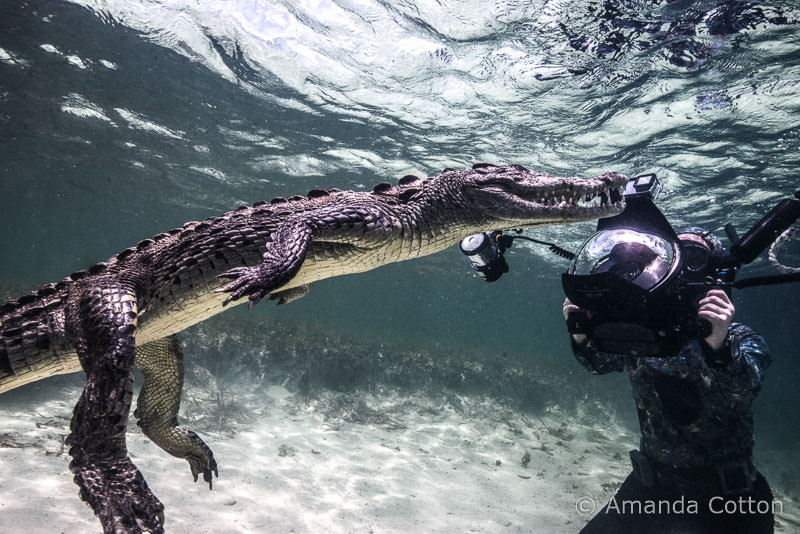
I highly recommend the 16-35mm wide angle lens. It is absolutely perfect for shooting the crocs! I also used the 8-15mm fisheye, but due to its wide nature it led me too close to the crocs, and into the “danger zone” too often. However, it was useful for getting some fun and creative vignette shots.
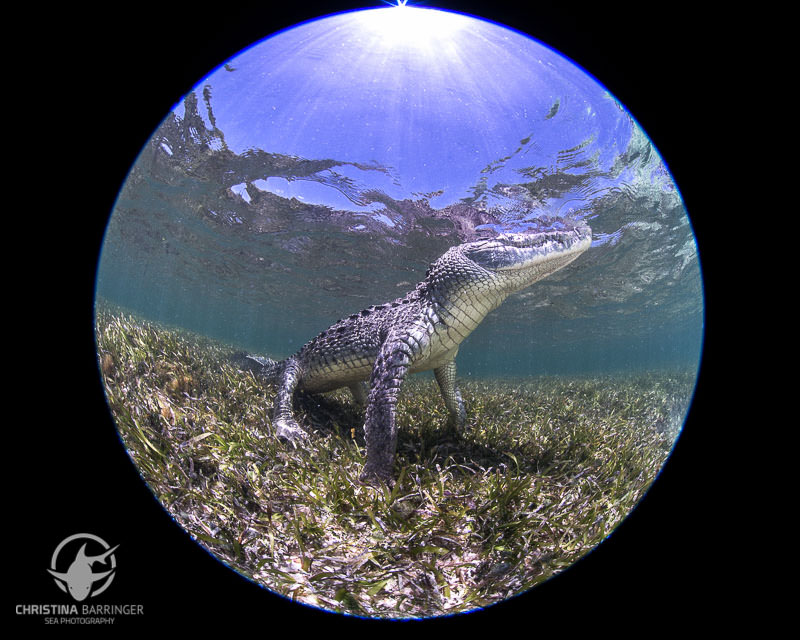
For wide angle, close wide angle, and split shots I’d recommend the 16-35mm. If you’re also seeking some vignettes, do this on the last day (after you’ve gotten the shots that you want) and after you’ve gotten comfortable in the water… but don’t get too comfortable! Remember to follow the rules for safety purposes and out of respect for the animals.
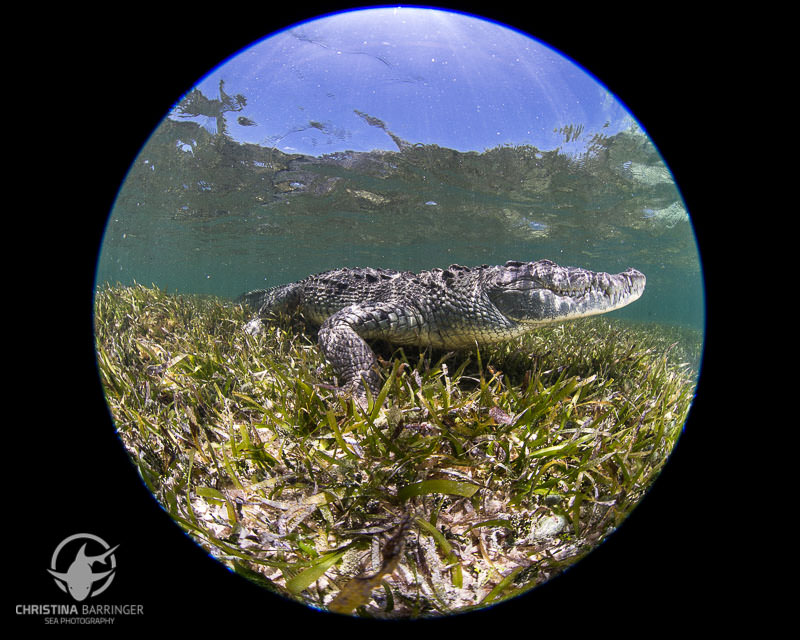
Safety
For safety reasons, only two divers at a time are allowed in the water alongside the crocodile wrangler, with rotations done throughout the day. The boat is docked at the fisherman hut, allowing us to enter the water at standing depth. We use a mask, snorkel, weight belt, and dive booties or water shoes.
It’s imperative to remember to stay within the designated sandy patch and to NOT for any reason enter the seagrass. The crocs approach at all angles and are well-camouflaged in the seagrass. The spotters on the boat are well trained in identifying incoming crocs, but it is much easier to spot crocs on the sandy patch, for obvious reasons. It is also helpful to keep one ear out of the water, allowing you to hear the spotters and your croc wrangler as they shout out the locations of crocs.
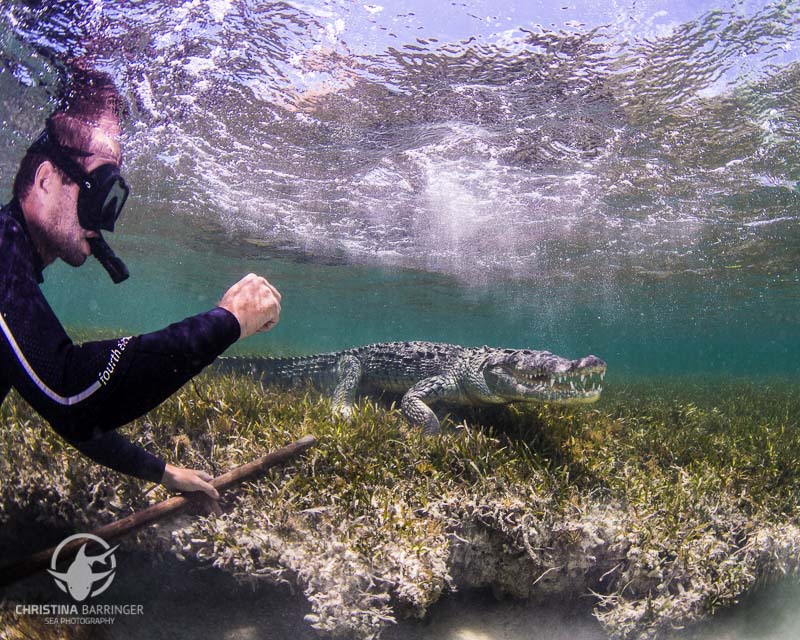
It’s important to remember that this is a no contact expedition. This is out of respect for the animals and in line with XTC Dive Center’s protocol. XTC Dive Center is the only dive operation that has a permit to offer this exciting experience; violating this regulation would jeopardize the entire operation.
Strategies of Approach
We all know the secret to underwater photography: get close! The “smartest” way to get close to these crocodiles is to approach them dead on, directly in front of them. When they strike they snap to the side, they don’t lunge forward with a bite. Directly to their side, (comparable to the blind spot of a car) is the danger zone and if you enter that zone you will get a quick tap on your shoulder from your croc expert letting you know it’s time to back up.
You will notice a “seagrass bed ledge” just before the sandy patch starts. When the crocs are at the edge of this ledge, it’s easy to carefully approach and get excellent shots with an upward angle, beautiful sun rays in shallow water, with minimal backscatter [depending on conditions (try not to shuffle and kick up the sand that you’re in). When multiple crocs move in, be extra cautious. Your croc wrangler expert will inform you if it’s best to exit the water. Crocs are territorial and if a fight breaks out, walk backwards towards the boat.
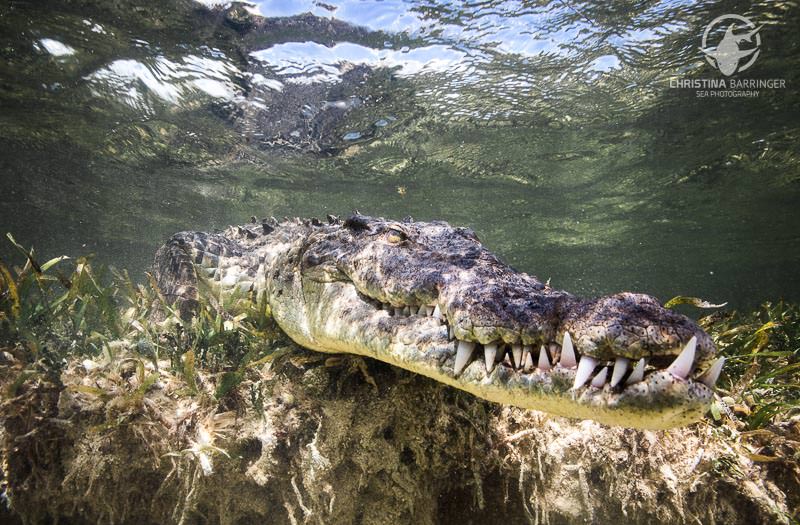
Shooting Techniques
It’s a big “no-no” in underwater photography to point your strobes directly at a subject, but there are always exceptions to the rules. If you’d like to light up the inside of a crocs mouth, tilt your strobes inward. Your “cone of light” should graze just past the tip of your dome. Then tone your strobes down a bit.
Remember to do this BEFORE approaching the croc. All adjustments to strobes, changes to settings, and sudden movements must be done before you approach the croc(s). If you need to make changes to your settings, you must back up (never turn your back to the croc). Adjust your settings at a distance, and then you may approach again. This is very important. The crocs are patient; it may appear as if they aren’t paying attention, but they are. They are studying you, and they are opportunistic predators. Never forget that.
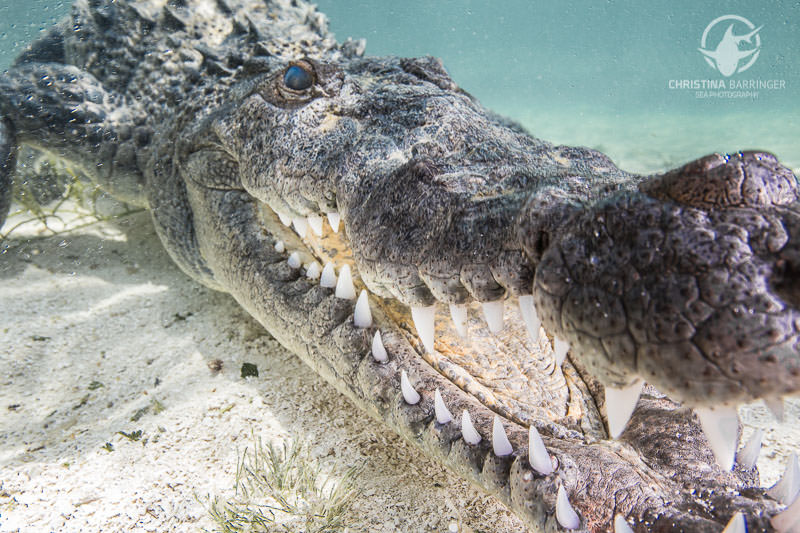
If you’re like me and a split shot is at the top of your list, this is the perfect place to get your dream split shot of this apex predator. They don’t open their mouths at the top of the water as often as you think, but it does happen. When it does, it happens quickly, so you have to be ready. Remember to bump up your aperture to ensure that you get the top of the water and the underwater portion in focus. (Editor’s note: for more info about taking great split shots, check out our detailed split shot tutorial).
Stay directly in front of the croc. If you’re not under the water with it, keep your camera down and between it and you (this is your barrier). Then, as the croc rises, rise with it, and prepare yourself for the gravity of holding your rig half out of the water. If you were shooting under the water you may have to adjust your settings; if you do, you must do this without looking at your camera, as you must keep your eye on the croc at all times. Once this magical moment happens, be ready to fire away! When the croc goes back down, again, lower your camera to keep it as a barrier between you and the croc. This took me a couple days to get right, but knowing this information should help shorten your learning curve.
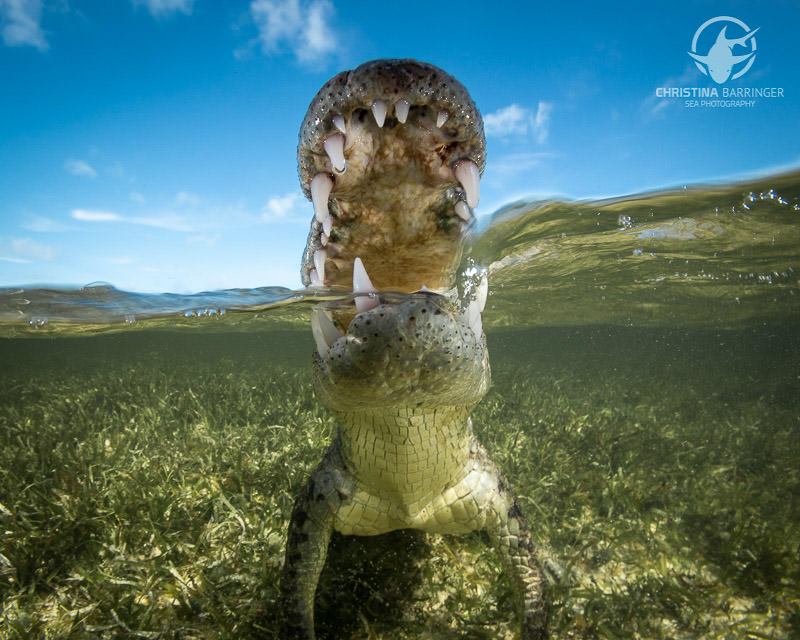
Why You Should Consider This Expedition
If these photos and the thought of this intrigues you, do it! If it excites you, do it! If it scares you, definitely do it! There is a phenomenon that occurs with facing your fears. It’s universal. You face them in one realm and suddenly you’re overcoming unrelated obstacles and fears in your everyday life. All of the greatest things I’ve done in my life, I was a little bit scared to do at first. This expedition is the perfect example of how facing your fears can have a powerfully positive outcome!
My first big award-winning photo came from this expedition - a 2nd place in the portrait category of the Ocean Art 2018 contest. It also inspired me to freedive with gators at Evergaldes Outpost. A photo from there won “Best of Photography 2018” in a local competition. The Ocean Art competition awarded me with a trip to Anilao, Philippines for a Bluewater Underwater Macro Photography Workshop, where I won two shootout competitions on the spot. All from facing my fears of freediving with crocodiles! How could this trip change your life?!
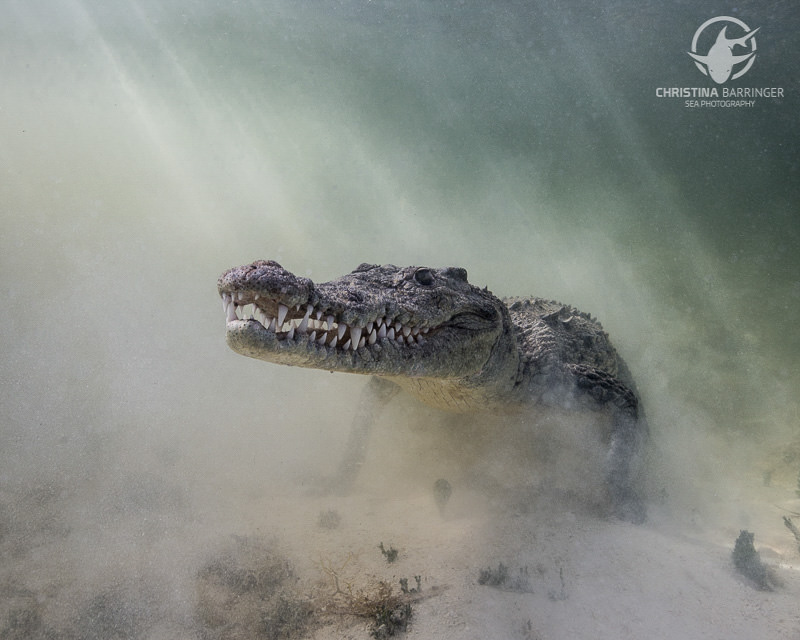
So what are you waiting for? If you want to do something extraordinary and you’re ready for the trip of a lifetime, go get in water with crocodiles in Banco Chinchorro!
Crocodiles of Banco Chinchorro from Christina Barringer on Vimeo.
Recommended for:
- Divers – Beginner up to professionals
- Underwater photographers – Beginner up to professionals
Book Your Next Exciting Trip!
If you want to find out more about diving this part of Mexico, or to book a crocodile dive trip, hop on over to our sister company Bluewater Travel’s info page.
Bluewater is also running a small-group Crocodiles & Cenotes Tour (includes 3 days in Banco Chinchorro) in August of 2019.
Or if you want to photograph crocodiles in a bit less intense of a setting, check out the BWT info page on diving Cuba.
For information about diving nearby Belize, check our Bluewater Travel's guide here.
Enter Your Photographs in Ocean Art
Ocean Art 2019 should be opening in August or September. Keep an eye on this page for updates on Ocean Art 2019 dates.
RECOMMENDED ARTICLES
SUPPORT THE UNDERWATER PHOTOGRAPHY GUIDE:
The Best Service & Prices on u/w Photo Gear
 Visit Bluewater Photo & Video for all your underwater photography and video gear. Click, or call the team at (310) 633-5052 for expert advice!
Visit Bluewater Photo & Video for all your underwater photography and video gear. Click, or call the team at (310) 633-5052 for expert advice!
The Best Pricing, Service & Expert Advice to Book your Dive Trips
 Bluewater Travel is your full-service scuba travel agency. Let our expert advisers plan and book your next dive vacation. Run by divers, for divers.
Bluewater Travel is your full-service scuba travel agency. Let our expert advisers plan and book your next dive vacation. Run by divers, for divers.
































